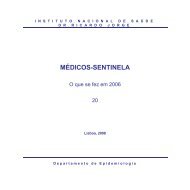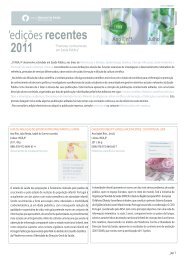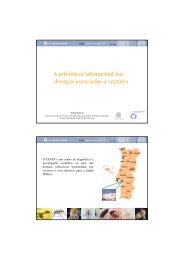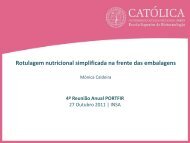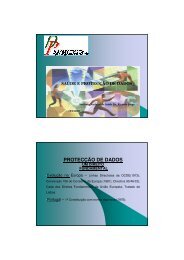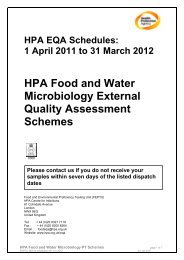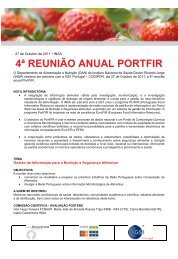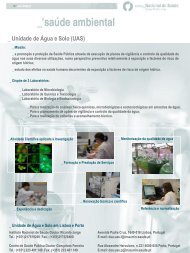European Society of Mycobacteriology - Instituto Nacional de Saúde ...
European Society of Mycobacteriology - Instituto Nacional de Saúde ...
European Society of Mycobacteriology - Instituto Nacional de Saúde ...
Create successful ePaper yourself
Turn your PDF publications into a flip-book with our unique Google optimized e-Paper software.
PP-6<br />
SPOLIGOTYPE PATTERNS AND DRUG RESISTANT<br />
PROFILE OF Mycobacterium tuberculosis IN SUDAN<br />
Ghada Suliman Sharaf-Eldin 1 , Imad F.Elmoula 1 , Mohammed S. Ali 1 , Nageeb S. Saaed 2 ,<br />
Ahammed B Ali 1 , Kim Mallard 3 , Ruth McNerney 3 , Saad Algamdi 3<br />
1 - Al Neelain University-Sudan<br />
2 - National Health Laboratory-Sudan<br />
3 - London School <strong>of</strong> Hygiene & Tropical Medicine.<br />
Sudan has a high bur<strong>de</strong>n <strong>of</strong> tuberculosis with an estimated 93,000 new cases each year. The purpose <strong>of</strong> this<br />
study was to investigate the genotypic patterns <strong>of</strong> M. tuberculosis strains circulating in Sudan and to assess<br />
their susceptibly to anti-tuberculosis drugs. Isolates from 237 smear positive tuberculosis patients were collected<br />
from different geographic regions <strong>of</strong> the country. Spoligotyping was performed by the Kamerbeek<br />
method and results were compared with the international SpolDB4 database (Institut Pasteur, Gua<strong>de</strong>loupe).<br />
Results revealed 28 clusters ranging in size from 12 to 57 isolates. Seventy unique (unclustered) strains were observed,<br />
representing 30% <strong>of</strong> the strains examined. The most frequently observed spoligotype patterns belonged to the CAS family<br />
which represented 115 (48.5%) <strong>of</strong> isolates studied. T1, H3, U and Beijing strains were found in 12 (5.1%), 11 (4.6%),<br />
7 (3%) and 6 (2.5%) patients respectively. Strains belonging to the Beijing family were found mainly in Western Sudan.<br />
Resistance to isoniazid, rifampicin, ethambutol and streptomycin was observed in 18.1, 22.4, 22.2 and 32% <strong>of</strong> strains respectively.<br />
Twenty patients (8.4%) had MDR-TB <strong>of</strong> which 10 were new cases. Seventeen patients with rifampicin resistant<br />
tuberculosis were infected with CAS1-DELHI strains matching SIT 25 <strong>of</strong> the SpolDB4 database and 3 were <strong>of</strong> the SIT<br />
1 Beijing family. 15 loci MIRU-VNTR typing subdivi<strong>de</strong>d the 17 CAS strains into one cluster <strong>of</strong> 5, two clusters <strong>of</strong> 2 and<br />
8 individual MIRU types. Similarly the 3 Beijing spoligotypes were differentiated into a cluster <strong>of</strong> 2 and a single strain.<br />
The use <strong>of</strong> molecular strain typing provi<strong>de</strong>s a proactive approach that may be used to initiate, and not just augment,<br />
traditional surveillance outbreak investigation in Sudan. However, caution must be used when interpreting clustered<br />
spoligotype patterns in this region.<br />
<strong>European</strong> <strong>Society</strong> <strong>of</strong> <strong>Mycobacteriology</strong> | 30 th Annual Congress | July 2009 | Porto - Portugal<br />
79



